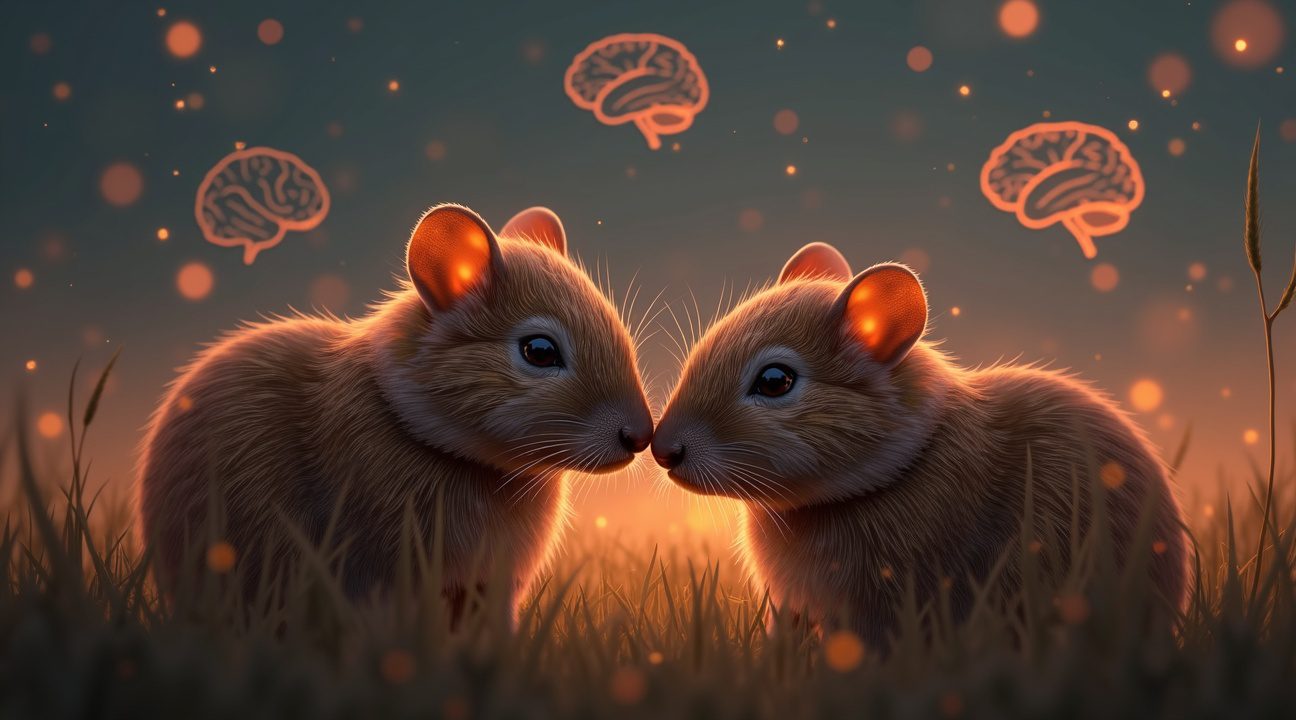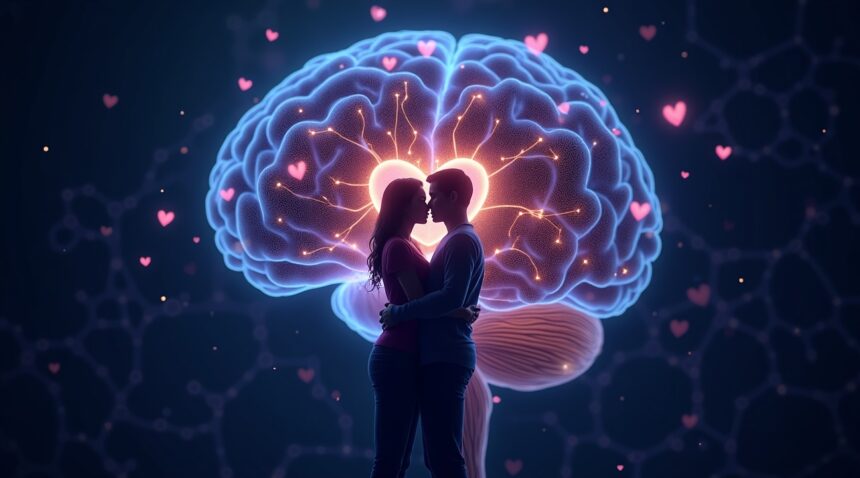Groundbreaking research reveals that love is not just an emotional experience but a fundamental biological necessity vital to human health and survival.
Key Takeaways
- Three key neurochemicals orchestrate love: Oxytocin, vasopressin, and dopamine work in harmony to build and maintain emotional bonds. Studies show oxytocin levels remain significantly elevated in romantic couples for at least six months.
- Love activates the same brain circuits as survival needs: Brain imaging demonstrates that romantic love stimulates the ventral tegmental area and nucleus accumbens—the same areas that respond to food, water, and other vital needs.
- Lack of loving relationships creates serious health consequences: Individuals lacking meaningful bonds show higher risks of cardiovascular disease, weakened immunity, increased inflammation, and greater chances of experiencing depression and anxiety disorders.
- Physical touch and affection provide measurable health benefits: Regular physical affection such as hugging promotes oxytocin production and lowers cortisol levels, which supports improved immune function, better quality sleep, and healthier cardiovascular metrics.
- Evolution hardwired humans for connection across all species: From microbes to mammals, nature favors social bonds. Isolated creatures consistently exhibit higher stress hormone levels, impaired health markers, and shorter lifespans.
Further Reading
To explore more about the science behind love and human connection, consider reading this article from Scientific American on why love is essential for survival.
Brain Chemistry Reveals Love’s Biological Blueprint
Three key neurochemicals orchestrate the complex dance of human attachment, transforming love from abstract emotion into measurable biological reality. Oxytocin, vasopressin, and dopamine work in concert to create the chemical foundation that drives pair bonding and sustains long-term relationships.
Research demonstrates that plasma oxytocin levels are significantly higher in romantic couples, with studies showing F(1,152) = 109.33, p < .001. This powerful hormone, often called the ‘love hormone’, influences far more than simple attraction. Oxytocin shapes trust levels, enhances empathy, strengthens bonding behaviors, increases physical touch sensitivity, and improves communication between partners. Elevated oxytocin appears in new romantic couples and maintains stable levels for at least six months, suggesting the brain’s commitment to sustaining attachment beyond initial attraction.
Neural Networks of Attachment
Advanced brain imaging reveals specific neural circuits that activate during experiences of passionate and maternal love. fMRI studies pinpoint crucial activation in the ventral tegmental area (VTA) and nucleus accumbens (NA), regions central to the brain’s reward processing system. These areas work alongside dopamine pathways to create the neurological framework for romantic attachment.
Dopamine functions as love’s motivational engine, driving the reward system that compels individuals to maintain bonds and pursue romantic connections. This neurotransmitter generates both ‘desire’ and ‘liking’ sensations, explaining why people experience powerful urges to spend time with romantic partners. The same reward circuitry that responds to food, water, and other survival necessities also responds to romantic love, positioning attachment as a fundamental biological drive rather than optional emotional experience.
Vasopressin contributes additional layers to this neurochemical symphony, particularly influencing long-term pair bonding and territorial behaviors that protect romantic relationships. Together, these three chemicals create a biological blueprint that ensures humans form lasting attachments necessary for species survival.
The brain’s sophisticated chemistry explains why love feels both compulsive and rewarding. Each interaction with a romantic partner triggers cascades of neurochemical activity that reinforce attachment behaviors. This biological programming helps explain complex psychological phenomena and demonstrates how evolution shaped human neurology to prioritize relationship formation.
Understanding love’s neurochemical foundation reveals that romantic attachment operates through the same essential systems that govern other survival behaviors. Brain chemistry doesn’t diminish love’s significance—it confirms that forming deep emotional bonds represents a biological imperative as fundamental as eating or sleeping.
Love Functions as Essential Life Support System
Love operates as a fundamental biological process that extends far beyond simple emotion. I’ve examined research showing that love functions as a dynamic, bidirectional system that’s essential for human flourishing, even when all other basic needs are satisfied. This isn’t just about feeling good – it’s about survival itself.
The human body treats loving relationships as a core requirement for maintaining healthy function. When people lose or lack these essential social bonds, their physiology becomes disrupted in measurable ways. Stress hormones surge, immune systems weaken, and the body’s natural homeostasis becomes compromised. Scientists have discovered that the absence of love creates a cascade of biological problems that can’t be solved by adequate food, shelter, or medical care alone.
The Health Consequences of Lost Connections
Research comparing humans with and without loving relationships reveals stark differences in health outcomes. People who experience the loss of close bonds face significantly increased risks of illness and mortality. The data is particularly striking when examining bereavement periods – the loss of a spouse or close family member doesn’t just create emotional pain, it triggers genuine physiological crisis that can prove fatal.
Studies consistently show that individuals without strong loving relationships experience:
- Higher rates of cardiovascular disease and stroke
- Compromised immune system function leading to increased infection rates
- Elevated stress hormone levels that damage organs over time
- Increased inflammation markers throughout the body
- Greater likelihood of developing depression and anxiety disorders
The biological machinery for love exists in every human brain from birth. As one expert explains, “The brain is hard-wired for love. All the connections are there, but the software is variable between individuals.” This variability helps explain why some people form bonds more easily than others, but it doesn’t change the fundamental truth that these connections are biologically necessary.
The brain’s love circuitry involves complex networks of neurons, hormones, and neurotransmitters that directly influence physical health. When these systems activate through loving relationships, they trigger protective biological responses. Blood pressure stabilizes, stress hormones decrease, and the immune system strengthens. These aren’t just correlations – they represent the body’s built-in recognition that love is a survival requirement.
Modern isolation and disconnection create genuine medical emergencies that traditional healthcare often overlooks. Understanding love as a biological necessity rather than luxury helps explain why social prescribing and relationship interventions can be as powerful as medications for certain conditions. The body simply functions better when the love systems are active and engaged. Scientists think they’ve discovered many mysteries about human connection, but the evidence is clear that love operates as life support for our species.
Evolution Hardwired Us for Connection Across All Species
Evolution has crafted love and social connection as fundamental survival tools that transcend species boundaries. I find it fascinating that what humans experience as romantic love or deep friendship actually represents millions of years of biological refinement, shaping our brains and bodies to prioritize relationships because they enhance our chances of survival and reproduction.
The Universal Drive for Social Bonds
Evolutionary biology reveals that the drive to form social bonds operates as a core survival strategy across virtually all life forms. From complex mammals to surprisingly simple organisms, life has consistently favored creatures that can cooperate, communicate, and care for one another. Even bacteria, those single-celled organisms we often think of as solitary, engage in sophisticated cooperative behaviors that benefit their entire community.
These microscopic social interactions demonstrate something profound about life itself. Bacteria share resources, communicate through chemical signals, and sacrifice individual advantages for group survival. When nutrients become scarce, some bacterial species will actually create protective films where individuals work together to ensure the colony’s survival. This cooperative behavior mirrors the same biological principles that drive human pair bonding and community formation.
Social Connection as an Evolutionary Principle
The renowned evolutionary biologist Theodosius Dobzhansky captured this concept perfectly when he stated, “Nothing in biology makes sense except in the light of evolution.” His observation applies directly to understanding why love feels so essential to human experience. Evolution hasn’t just shaped our physical bodies; it has programmed our brains to crave connection because isolation historically meant death.
Consider how this principle manifests across different species:
- Pack animals like wolves develop intricate social hierarchies and emotional bonds that improve hunting success and offspring survival.
- Birds engage in complex courtship rituals and often mate for life, sharing parenting duties that dramatically increase their reproductive success.
- Insects like ants and bees have evolved sophisticated social structures where individual sacrifice for the group creates powerful survival advantages.
Life on Earth operates as fundamentally social because cooperation consistently outperforms competition in the long-term evolutionary game. I observe this pattern repeating across ecosystems, from coral reefs where different species form symbiotic relationships to primate communities where social grooming and alliance-building determine individual success within the group.
Modern neuroscience supports these evolutionary insights by revealing how our brains release powerful chemical rewards when we form social connections. The same neural pathways that make us feel good about romantic love also activate during friendships, parent-child bonding, and even positive interactions with pets. These brain mechanisms evolved because individuals who could form and maintain social bonds consistently outsurvived those who couldn’t.
Research shows that isolated individuals across species experience elevated stress hormones, compromised immune systems, and shortened lifespans. Conversely, socially connected individuals demonstrate better physical health, enhanced cognitive function, and increased longevity. These patterns appear so consistently across different species that scientists now consider social connection a biological necessity rather than a psychological luxury.
Evolution has essentially hardwired us to need each other, creating biological systems that make isolation painful and connection rewarding. This explains why humans can form emotional attachments to everything from romantic partners to beloved pets to fictional characters in books and movies. Our brains evolved to seek and maintain social bonds because those connections have always meant the difference between survival and extinction.
Understanding love through an evolutionary lens doesn’t diminish its beauty or significance. Instead, it reveals love as one of life’s most successful strategies, refined across millions of years and countless species. The butterflies you feel during a first kiss, the comfort of a friend’s embrace, and the deep satisfaction of caring for others all represent your evolutionary heritage expressing itself through modern experience.

Prairie Voles Unlock Secrets of Monogamous Love
The tiny prairie vole holds extraordinary secrets about love’s biological foundations. These small rodents belong to an exclusive group representing only 3–5% of mammals that form monogamous pairs, making them invaluable research subjects for understanding the neurochemistry of attachment.
Prairie voles demonstrate remarkable fidelity throughout their lives, establishing long-term bonds that persist until death. When one partner dies, the surviving vole exhibits grief-like behaviors that mirror human responses to loss. This observable emotional reaction provides researchers with concrete evidence that love extends far beyond human experience.
Neurochemical Pathways Drive Attachment
Animal studies involving voles and rats have identified the precise brain mechanisms that create lasting bonds. Scientists discovered that oxytocin and dopamine activation in the ventral tegmental area (VTA) and nucleus accumbens (NA) serves as the foundation for pair bond formation. These findings emerged from direct experimentation where researchers blocked these pathways and observed that voles could no longer form attachments.
The research reveals specific receptor activity essential for bonding. Activation of D2-type dopamine receptors alongside oxytocin in the nucleus accumbens creates the neurochemical signature of attachment. When scientists prevented this activation, voles showed no interest in forming partnerships, confirming the biological necessity of these pathways.
The parallels between human love and vole bonding extend beyond simple attachment. Both species exhibit similar patterns in:
- Caregiving behaviors
- Protective instincts
- Stress responses when separated from partners
Scientists think they’ve discovered that these shared neurological foundations suggest love evolved as a survival mechanism across multiple species.
Comparative animal models demonstrate that the same brain regions activated during human romantic attachment light up in monogamous voles. The VTA and NA activation patterns remain consistent across species, indicating that love’s biological basis transcends individual animals and represents a fundamental evolutionary adaptation.
These discoveries challenge the notion that love is purely emotional or psychological. Instead, prairie voles reveal that monogamous bonding relies on specific neurochemical processes that can be measured, manipulated, and understood through scientific investigation. The research provides concrete evidence that attachment behaviors stem from biological imperatives rather than abstract feelings alone.

Physical Touch and Hugging Boost Health Through Love Chemistry
Physical affection creates measurable improvements in health markers that scientists can now track with precision. Close, supportive relationships generate higher oxytocin levels while simultaneously reducing stress hormones throughout the body. Couples who frequently hug and offer mutual support maintain elevated oxytocin production, which directly lowers stress responses and supports balanced emotional well-being.
Physiological Changes From Loving Contact
The body responds to affectionate touch with dramatic physiological shifts that enhance overall health. Cortisol levels drop significantly when people engage in regular hugging and supportive behaviors with their partners. Immune function strengthens as stress hormones decrease, creating a biological environment that fights off illness more effectively.
Hugging and other forms of affectionate touch sustain oxytocin release for extended periods, providing ongoing mental health benefits. This hormone doesn’t just create feelings of connection – it actively supports cardiovascular health, reduces inflammation, and improves sleep quality. Regular physical contact with loved ones creates a feedback loop where reduced stress leads to better health outcomes, which in turn supports stronger relationships.
The Cost of Love Deprivation
Love deprivation carries serious health consequences that extend far beyond emotional discomfort. Scientists have documented “broken heart” syndrome, a condition where emotional trauma actually damages heart muscle and creates symptoms similar to a heart attack. This demonstrates how deeply the brain processes emotional experiences through physical pathways.
People who lack regular supportive contact show elevated stress hormones, compromised immune systems, and increased inflammation markers. Their bodies remain in a chronic state of stress that accelerates aging and increases disease risk. The absence of oxytocin-producing interactions leaves individuals more vulnerable to depression, anxiety, and physical illness.
Physical touch serves as a biological necessity rather than simply a pleasant experience. The health benefits emerge from consistent, appropriate contact that signals safety and support to the nervous system. Even brief moments of affectionate touch can trigger oxytocin release and begin the cascade of positive health effects that loving relationships provide.

How Love Hormones Create Lasting Bonds in Your Brain
Love isn’t just an abstract feeling floating through your consciousness—it’s a powerful biological process driven by specific hormones that literally rewire your brain for connection. When scientists examine oxytocin (OT) levels in new couples compared to singles, they discover fascinating patterns that reveal how your body orchestrates romantic attachment. Fresh couples show dramatically elevated oxytocin concentrations, and these levels remain remarkably stable over six months, suggesting your brain commits to long-term bonding from the early stages of romance.
The Chemical Symphony of Attachment
Research consistently demonstrates a strong correlation between elevated oxytocin levels and positive relationship behaviors. Couples with higher OT concentrations engage in more affectionate touch, experience synchronized emotional states, and display increased empathy toward their partners. This hormonal influence extends beyond simple mood changes—it fundamentally alters how you perceive and respond to your romantic partner.
Animal studies provide compelling evidence for these bonding mechanisms. Prairie voles, known for their monogamous behavior, exhibit grief responses remarkably similar to humans when separated from their mates. These creatures show distinct neurochemical signatures that scientists recognize as markers for unique bonds—specific brain patterns that distinguish a special partner from all others. The parallels between animal and human attachment systems suggest love operates through ancient, deeply embedded biological programs.
Brain Circuits Built for Connection
The interplay between dopamine and oxytocin creates the foundation for both forming and maintaining loving attachments. Dopamine drives the initial motivation and excitement of new love, while oxytocin solidifies the bond and promotes long-term commitment. Direct neuroimaging evidence shows these chemicals work together to activate specific brain regions associated with reward, motivation, and attachment.
Brain scans reveal that loving relationships trigger activation in your reward circuitry—the same neural networks involved in addiction and pleasure-seeking behaviors. This activation creates powerful motivation to maintain close bonds with your romantic partner. Your brain literally treats love like a biological necessity, similar to how it responds to food or safety needs.
Scientists have identified specific neural pathways that differentiate romantic love from other types of affection. These circuits involve the ventral tegmental area, nucleus accumbens, and anterior cingulate cortex—regions that process reward, motivation, and emotional significance. When you experience love, these areas light up in distinctive patterns that researchers can now predict and measure.
The formation of lasting pair bonds involves complex neurochemical cascades that strengthen over time. Initial attraction triggers dopamine release, creating feelings of euphoria and motivation to pursue the relationship. As the bond deepens, oxytocin levels increase, promoting trust, empathy, and long-term attachment. This hormonal progression explains why early relationship excitement gradually transforms into deeper, more stable connection.
Your brain’s attachment system also explains why losing a loved one feels so devastating. The same neural circuits that create bonds also register their absence as a threat to survival. Scientists think they’ve discovered that disrupted attachment triggers stress responses similar to physical pain, highlighting love’s biological importance.
Neuroimaging studies show that people in stable, loving relationships display enhanced connectivity between brain regions responsible for emotional regulation and social cognition. These structural changes suggest that sustained love actually remodels your neural architecture, creating more efficient pathways for empathy, communication, and cooperation.
The evidence overwhelmingly supports love as a fundamental biological drive rather than a cultural construct. Your brain dedicates significant resources to forming and maintaining romantic bonds because successful partnerships historically improved survival and reproductive success. Modern neuroscience reveals that these ancient systems continue operating today, creating the neurochemical foundation for meaningful relationships and emotional well-being.
Sources:
National Institutes of Health (NIH) – “The neurobiology of pair bonding: Insights from a socially monogamous rodent”
National Institutes of Health (NIH) – “Oxytocin and social bonding in humans”
Noba Project – “The Biochemistry of Love”
Healthline – “What to Know About the ‘Love Hormone’ Oxytocin”
University of Colorado Boulder – “Science confirms it: Love leaves a mark on your brain”
American Heart Association – “This is your brain on love”
National Institutes of Health (NIH) – “Oxytocin, the ‘love hormone,’ and its role in human behaviors, including trust and bonding”
National Institutes of Health (NIH) – “The Social Neuroscience of Human–Animal Bonding”


